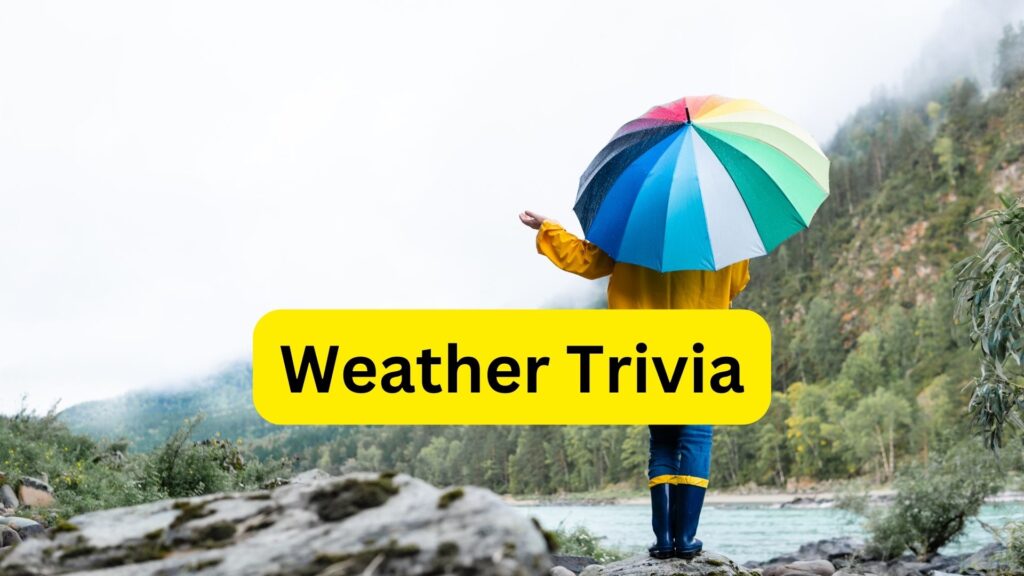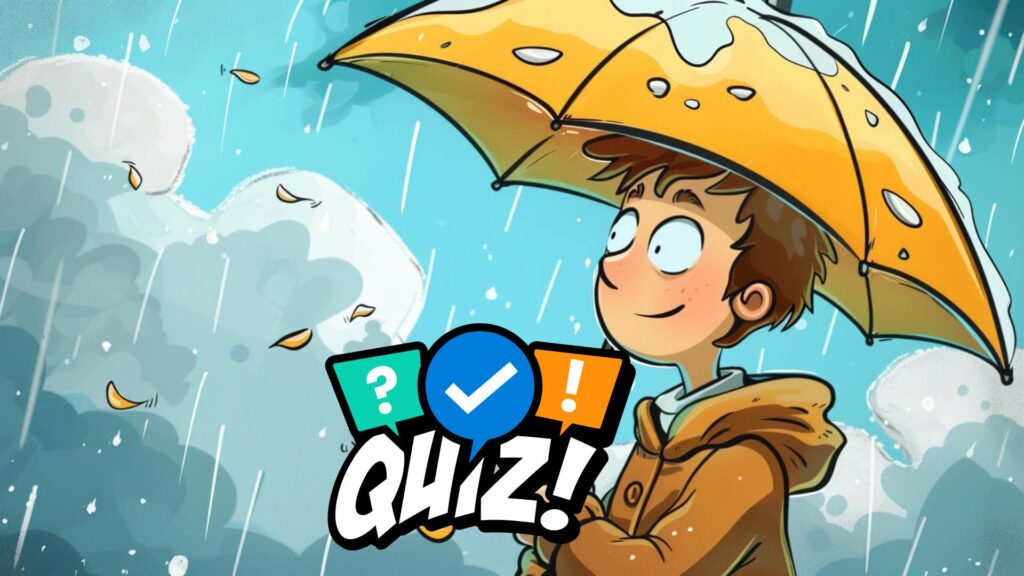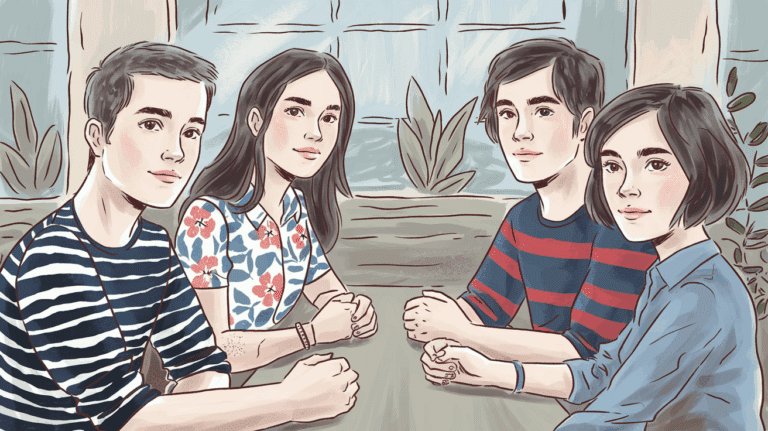Let’s dive into the world of weather trivia! We all know how the weather affects our daily lives, from planning outdoor activities to choosing what to wear. But there’s so much more to learn about this interesting subject.
I’ve compiled a list of over 211+ weather trivia questions that will test your knowledge and teach you new facts. In this article, you’ll find questions covering various aspects of weather, from basic concepts to unusual phenomena.
Whether you’re a weather enthusiast or just curious about the world around you, these trivia questions will entertain and educate you.
Get ready to impress your friends with your weather wisdom and maybe even learn something new along the way!
Interesting Weather Trivia Facts You Didn’t Know

-
What causes rainbows?
A: Sunlight refracting and reflecting through water droplets in the air. -
How does a tornado form?
A: When warm, moist air collides with cool, dry air, creating a rotating column of air. -
What’s the difference between weather and climate?
A: Weather is short-term atmospheric conditions, while climate is the average weather patterns over a long period. -
How are hurricanes categorized?
A: Using the Saffir-Simpson Hurricane Wind Scale from Category 1 to 5. -
What tool measures atmospheric pressure?
A: A barometer. -
What’s the name for a scientist who studies weather?
A: Meteorologist. -
Which gas makes up the largest percentage of Earth’s atmosphere?
A: Nitrogen (about 78%). -
What causes wind?
A: Differences in air pressure between areas. -
What’s the layer of the atmosphere closest to Earth’s surface?
A: Troposphere. -
What’s a microburst in weather terms?
A: A small, intense downdraft that causes damaging winds. -
What’s the dewpoint?
A: The temperature at which water vapor condenses into liquid water. -
What causes fog?
A: Water vapor condensing near the ground. -
What’s a heat index?
A: How hot it feels when relative humidity is combined with air temperature. -
What’s lake effect snow?
A: Snow that forms when cold air moves over warmer lake water. -
What’s an isobar on a weather map?
A: A line connecting points of equal atmospheric pressure. -
What’s the eye of a hurricane?
A: The calm center of the storm with low winds and clear skies. -
What’s a Chinook wind?
A: A warm, dry wind that descends the eastern slopes of the Rocky Mountains. -
What is a Chinook wind?
A: A warm, dry wind that descends the eastern slopes of the Rocky Mountains. -
What’s a supercell?
A: A thunderstorm with a deep, persistently rotating updraft. -
What’s virga in meteorology?
A: Precipitation that evaporates before reaching the ground. -
What’s a snow squall?
A: An intense, short-lived burst of heavy snow with strong winds. -
What’s the difference between sleet and freezing rain?
A: Sleet is ice pellets, while freezing rain is liquid that freezes on contact with surfaces. -
What’s a temperature inversion?
A: When air temperature increases with altitude instead of decreasing. -
What’s the cumulonimbus cloud also known as?
A: Thunderhead. -
What causes sea breeze?
A: Temperature differences between land and sea during the day. -
What’s a cold front?
A: The leading edge of a cooler mass of air replacing a warmer mass of air. -
What’s the Koppen climate classification system?
A: A method for categorizing Earth’s climates based on temperature and precipitation patterns. -
What was the deadliest hurricane in U.S. history?
A: The Great Galveston Hurricane of 1900. -
When did the Dust Bowl occur?
A: During the 1930s. -
What year was the Great Blizzard of 1888?
A: 1888. -
How did the 2004 Indian Ocean tsunami impact weather patterns?
A: It caused temporary cooling in the affected regions due to increased cloud cover and rainfall. -
What caused the Year Without a Summer in 1816?
A: The eruption of Mount Tambora in Indonesia in 1815. -
Which hurricane caused the most economic damage in U.S. history?
A: Hurricane Katrina in 2005. -
When did the Great Smog of London occur?
A: December 1952. -
What year saw the deadliest tornado in U.S. history?
A: 1925 (The Tri-State Tornado). -
When did the North American Ice Storm of 1998 occur?
A: January 1998. -
Which year had the most active Atlantic hurricane season on record?
A: 2020. -
When did the Great Mississippi Flood occur?
A: 1927. -
What year saw the formation of the Ozone Hole over Antarctica?
A: 1985 (first observed). -
When was the hottest year on record globally?
A: 2016 (tied with 2020). -
What year did the “Storm of the Century” hit the eastern United States?
A: 1993. -
When did the Great Flood of 1993 affect the American Midwest?
A: Summer of 1993. -
What year saw the European heat wave that caused thousands of deaths?
A: 2003. -
When did Hurricane Andrew devastate Florida?
A: August 1992. -
What year did the Bhola Cyclone, the world’s deadliest tropical cyclone, hit East Pakistan (now Bangladesh)?
A: 1970. -
When did the Great Freeze in Florida occur, devastating citrus crops?
A: 1894-1895. -
What year did the Perfect Storm (Halloween Nor’easter) occur?
A: 1991. -
When was the Great Frost of 1709 in Europe?
A: Winter of 1708-1709. -
What year saw the formation of Hurricane Wilma, the most intense Atlantic hurricane on record?
A: 2005. -
When did the Great Heat Wave of 1936 occur in North America?
A: Summer of 1936. -
What year did the Schoolhouse Blizzard, also known as the Children’s Blizzard, occur in the American Great Plains?
A: 1888. -
When did the Great Arctic Outbreak bring record low temperatures to the United States?
A: February 1899. -
What year saw the deadliest known meteorological disaster, the Central China floods?
A: 1931. -
When did the Sydney hailstorm, the costliest natural disaster in Australian insurance history, occur?
A: April 1999. -
Who is considered the father of modern meteorology?
A: Vilhelm Bjerknes. -
What’s the primary role of a meteorologist?
A: To study and predict weather and climate. -
How do satellites help in weather forecasting?
A: By providing real-time images and data of atmospheric conditions. -
What’s a weather balloon, and how is it used?
A: A balloon that carries instruments to measure atmospheric conditions at various altitudes. -
How has weather prediction technology evolved over the years?
A: From simple observations to complex computer models and artificial intelligence. -
What’s the World Meteorological Organization (WMO)?
A: A specialized agency of the United Nations for meteorology and related sciences. -
What’s a radiosonde?
A: An instrument package carried by weather balloons to measure atmospheric conditions. -
How does Doppler radar work in weather forecasting?
A: By detecting the motion of precipitation to determine wind speed and direction. -
What’s the difference between numerical weather prediction and statistical weather forecasting?
A: Numerical prediction uses mathematical models, while statistical forecasting relies on historical data patterns. -
What’s a weather station?
A: A facility with instruments to measure various weather parameters. -
How do meteorologists use computer models in forecasting?
A: To simulate atmospheric conditions and predict future weather patterns. -
What’s the purpose of the Beaufort Scale?
A: To measure wind speed based on observed sea conditions. -
What’s an anemometer used for in meteorology?
A: To measure wind speed. -
How does a hygrometer work?
A: It measures the amount of moisture in the air (humidity). -
What’s the difference between relative humidity and absolute humidity?
A: Relative humidity is the amount of moisture in the air compared to what it can hold, while absolute humidity is the actual amount of water vapor in the air. -
What’s a pyranometer used for?
A: To measure solar radiation. -
How do weather buoys contribute to meteorology?
A: By providing weather and ocean data from remote marine locations. -
What’s the purpose of a rain gauge?
A: To measure the amount of liquid precipitation over a set period of time. -
How does LIDAR technology assist in meteorology?
A: By using laser pulses to measure atmospheric properties like aerosols and wind. -
What’s the difference between weather radar and weather satellite imagery?
A: Radar detects precipitation and wind, while satellites provide broader views of cloud patterns and atmospheric conditions. -
How do meteorologists use isotherms on weather maps?
A: To show areas of equal temperature. -
What’s the purpose of a sling psychrometer?
A: To measure relative humidity using wet and dry bulb temperatures. -
How do meteorologists use atmospheric soundings?
A: To analyze vertical profiles of temperature, humidity, and wind in the atmosphere. -
What’s the role of supercomputers in modern meteorology?
A: To process vast amounts of data and run complex weather models quickly. -
How do meteorologists use ensemble forecasting?
A: To generate multiple forecast scenarios and assess forecast uncertainty. -
What’s the difference between a meteorologist and a climatologist?
A: Meteorologists focus on short-term weather patterns, while climatologists study long-term weather trends. -
How do weather balloons contribute to upper-air observations?
A: By providing data on temperature, humidity, and wind at various altitudes. -
What’s the highest recorded temperature on Earth?
A: 134°F (56.7°C) in Death Valley, California, USA (1913). -
What’s the coldest place on Earth?
A: East Antarctic Plateau (lowest recorded temperature: -128.6°F or -89.2°C). -
How do lightning and thunder occur?
A: Lightning is an electrical discharge, and thunder is the sound caused by rapidly heating and expanding air around the lightning bolt. -
What’s a haboob?
A: An intense dust storm or sand storm common in arid regions. -
How are blizzards different from regular snowstorms?
A: Blizzards have sustained winds or frequent gusts of 35 mph or more, along with considerable falling or blowing snow. -
What’s the strongest recorded wind speed on Earth?
A: 253 mph (407 km/h) during Tropical Cyclone Olivia at Barrow Island, Australia (1996). -
What causes a heat dome?
A: A high-pressure system that traps hot air underneath it. -
What’s a polar vortex?
A: A large area of low pressure and cold air surrounding the Earth’s poles. -
What’s the difference between a waterspout and a tornado?
A: Waterspouts form over water, while tornadoes form over land. -
What’s a fire whirl?
A: A spinning vortex of flame and ash that can occur during intense fires. -
What causes ball lightning?
A: It’s a rare phenomenon whose exact cause is still debated by scientists. -
What’s a snow devil?
A: A rotating column of wind that picks up loose snow from the ground, similar to a dust devil. -
What’s the wettest place on Earth?
A: Mawsynram, India (average annual rainfall: 467 inches or 11,862 mm). -
What causes flash floods?
A: Intense rainfall over a short period, often combined with poor drainage. -
What’s a heat burst?
A: A rare atmospheric phenomenon characterized by a sudden temperature increase and wind gusts, typically occurring at night. -
What’s the difference between a landspout and a tornado?
A: Landspouts form during the growth stage of a thunderstorm, while tornadoes are associated with mature thunderstorms. -
What’s a megacryometeor?
A: An extremely large hailstone or ice chunk that falls from the sky, often in clear weather. -
What causes a dust devil?
A: Rapidly rising air creating a small, rotating column of wind. -
What’s a triple point in meteorology?
A: The point at which three atmospheric fronts meet, such as warm, cold, and occluded fronts. -
What’s the difference between a tropical storm and a hurricane?
A: Wind speed – tropical storms have sustained winds of 39-73 mph, while hurricanes have winds of 74 mph or higher. -
What causes a heatwave?
A: A prolonged period of abnormally hot weather, often caused by a high-pressure system. -
What’s a gustnado?
A: A short-lived, ground-based rotating column of air that can form on the leading edge of a severe thunderstorm. -
What’s the driest place on Earth?
A: The Atacama Desert in Chile (some areas have never recorded rainfall). -
What causes a microburst?
A: A small-scale, intense downdraft that produces damaging winds. -
What’s a bomb cyclone?
A: A rapidly intensifying low-pressure system characterized by a quick drop in atmospheric pressure. -
What’s the difference between lake-effect snow and regular snow?
A: Lake-effect snow forms when cold air moves over warmer lake water, picking up moisture and depositing it as snow on the leeward shores. -
What causes a heat island effect?
A: Urban areas with lots of concrete and asphalt absorbing and retaining heat, making them warmer than surrounding rural areas.
-
Does lightning ever strike the same place twice?
A: Yes, it can and often does, especially tall structures like skyscrapers. -
Can you catch a cold from being in the rain?
A: No, colds are caused by viruses, not by being cold or wet. -
Is it true that tornadoes never hit big cities?
A: No, tornadoes can and do hit cities, though it’s less common due to less open space. -
Can animals predict the weather?
A: Some animals may be sensitive to changes in air pressure or other environmental factors, but they can’t truly predict weather. -
Is the saying “Red sky at night, shepherd’s delight” scientifically accurate?
A: It can be, as red skies at sunset often indicate high pressure and good weather approaching from the west. -
Do all snowflakes have six sides?
A: While most do, some can have three or twelve sides depending on temperature and humidity. -
Is it true that you lose most of your body heat through your head?
A: No, you lose heat from any exposed part of your body at roughly the same rate. -
Can opening windows during a tornado help equalize pressure?
A: No, this is a myth and can actually be dangerous during a tornado. -
Does hot water freeze faster than cold water?
A: Sometimes, due to the Mpemba effect, but it’s not always the case and depends on various factors. -
Is it safe to take shelter under a highway overpass during a tornado?
A: No, this is dangerous as it can create a wind tunnel effect. -
Do hurricanes only form over warm water?
A: Generally yes, they require water temperatures of at least 79°F (26°C). -
Is it true that you should stick your car keys in your mouth to extend their range?
A: No, this is a myth. Your head doesn’t significantly amplify the signal. -
Do metal objects attract lightning?
A: Metal doesn’t attract lightning, but it does conduct electricity if struck. -
Is it true that you can tell the temperature by counting cricket chirps?
A: There’s some truth to this – cricket chirping rates are temperature-dependent. -
Does lightning never strike the ocean?
A: False, lightning does strike the ocean, but it dissipates quickly in the water. -
Is it true that tornadoes don’t cross rivers?
A: No, tornadoes can and do cross rivers, mountains, and other terrain features. -
Do full moons cause more births or crime?
A: Despite popular belief, scientific studies haven’t found a significant correlation. -
Is it true that you should open your windows during a hurricane?
A: No, this is an outdated and potentially dangerous myth. -
Does a green sky always mean a tornado is coming?
A: While a green sky can indicate severe weather, it doesn’t always mean a tornado is imminent. -
Is it safe to use a landline phone during a thunderstorm?
A: No, it’s best to avoid using corded phones during thunderstorms due to the risk of electrical discharge. -
Do pine cones open when good weather is coming?
A: Pine cones open in dry conditions, which often coincide with fair weather, but it’s not a reliable predictor. -
Is it true that lightning never strikes the same place twice?
A: No, lightning can and often does strike the same place multiple times. -
Does frost on the inside of windows indicate very cold temperatures outside?
A: Not necessarily. It often indicates high indoor humidity combined with cold outside temperatures. -
Is it true that a ring around the moon means rain is coming?
A: While it can indicate moisture in the atmosphere, it’s not a guaranteed sign of rain. -
Do earthquakes cause changes in weather?
A: Generally no, earthquakes don’t directly affect weather patterns. -
Is it true that you can tell the temperature by how high birds are flying?
A: This is a myth. Birds’ flight altitudes depend on various factors, not just temperature. -
Does warm air always rise?
A: In most cases yes, but there are exceptions like temperature inversions. -
What’s a monsoon, and where does it occur?
A: A seasonal change in wind direction causing dry and wet seasons, common in South Asia and other tropical regions. -
What’s the Aurora Borealis, and where can you see it?
A: The Northern Lights, visible in high-latitude regions like Alaska, Canada, and Scandinavia. -
How does El Niño affect global weather?
A: It causes warming of the Pacific Ocean, leading to changes in global weather patterns. -
What’s the difference between a typhoon and a cyclone?
A: They’re the same phenomenon (tropical cyclones) named differently based on location. -
What are the wettest and driest places on Earth?
A: Wettest: Mawsynram, India. Driest: Atacama Desert, Chile. -
What causes the Saharan Air Layer?
A: A mass of very dry, dusty air that forms over the Sahara Desert and moves across the Atlantic Ocean. -
What’s a rain shadow?
A: An area of reduced rainfall on the lee side of a mountain range. -
What causes the Asian Dust phenomenon?
A: Strong winds carrying dust from the deserts of Mongolia and China. -
What’s a Chinook wind?
A: A warm, dry wind that blows down the eastern slopes of the Rocky Mountains. -
What causes the Indian Summer?
A: A period of unseasonably warm, dry weather in autumn in temperate regions. -
What’s the Intertropical Convergence Zone (ITCZ)?
A: The area near the equator where northeast and southeast trade winds converge. -
What causes the Pampero winds in South America?
A: A burst of cold polar air from the south in the Pampas of Argentina and Uruguay. -
What’s a Katabatic wind?
A: A wind that carries high-density air from a higher elevation down a slope under gravity. -
What causes the Mistral wind in France?
A: A strong, cold, northwesterly wind that blows through the Rhône valley and southern France. -
What’s a dust storm, and where are they common?
A: A strong wind carrying clouds of dust, common in arid and semi-arid regions. -
What causes the Sirocco wind in North Africa and Southern Europe?
A: A hot, dusty wind from the Sahara that blows northward across the Mediterranean. -
What’s a heat island, and where do they occur?
A: Urban areas that are significantly warmer than surrounding rural areas due to human activities. -
What causes the Foehn effect?
A: A warm, dry wind on the lee side of a mountain range. -
What’s lake-effect snow, and where does it occur?
A: Heavy snowfall that occurs when cold air moves over warmer lake waters, common near the Great Lakes. -
What causes the Santa Ana winds in Southern California?
A: Strong, extremely dry offshore winds that sweep through Southern California. -
What’s a nor’easter?
A: A macro-scale cyclone occurring along the upper East Coast of the United States and Atlantic Canada. -
What causes the Jet Stream, and how does it affect weather?
A: A narrow band of strong winds in the upper atmosphere that influences weather patterns. -
What’s a heat dome, and where do they form?
A: A high-pressure system that traps hot air underneath it, can form over any large geographical area. -
What causes the Harmattan wind in West Africa?
A: A dry and dusty northeasterly wind that blows from the Sahara Desert over West Africa. -
What’s a polar vortex, and how does it affect weather?
A: A large area of low pressure and cold air surrounding the Earth’s poles, can bring extreme cold to mid-latitude regions. -
What causes the Bora wind in the Adriatic region?
A: A northern to northeastern katabatic wind in the Adriatic, Croatia, Montenegro, and parts of Slovenia and Italy. -
What’s the Pacific Decadal Oscillation, and how does it affect climate?
A: A long-lived El Niño-like pattern of Pacific climate variability that affects temperatures and precipitation patterns. -
What makes the sky blue?
A: Sunlight scattering in the atmosphere, with blue light scattering more than other colors. -
Why do leaves change color in the fall?
A: As chlorophyll breaks down, other pigments become visible. -
How are clouds formed?
A: When water vapor in the air condenses into tiny water droplets or ice crystals. -
What’s hail, and how is it different from snow?
A: Hail is balls of ice, while snow is crystallized water. -
Why do we see our breath in cold weather?
A: Water vapor in our breath condenses in the cold air. -
What makes a rainbow?
A: Sunlight refracted and reflected by water droplets in the air. -
Why does it rain?
A: When water droplets in clouds become too heavy and fall as rain. -
What causes thunder?
A: The rapid heating and expansion of air around a lightning bolt. -
Why do some places have four seasons while others don’t?
A: Due to the tilt of the Earth’s axis and distance from the equator. -
How do snowflakes form?
A: When water vapor freezes around tiny particles in clouds. -
What’s a sundog?
A: A bright spot on either side of the sun, caused by light refraction through ice crystals. -
Why does the wind blow?
A: Due to differences in air pressure between areas. -
What’s dew, and how does it form?
A: Water droplets that form on cool surfaces when water vapor condenses. -
Why do we have day and night?
A: Because the Earth rotates on its axis. -
What’s a weather vane used for?
A: To show which direction the wind is blowing from. -
Why does it feel colder when the wind blows?
A: Wind removes the warm air layer next to your skin, making you feel colder. -
What’s frost, and how does it form?
A: A thin layer of ice that forms when water vapor in the air freezes on cold surfaces. -
Why do we have different types of clouds?
A: Due to different altitudes, temperatures, and moisture levels in the atmosphere. -
What’s the water cycle?
A: The continuous movement of water on, above, and below the surface of the Earth. -
Why does it snow instead of rain when it’s cold?
A: Snow forms when water vapor freezes directly into ice crystals in cold air. -
What’s fog, and how does it form?
A: A cloud that forms near the ground when water vapor condenses in cool air. -
Why do we sometimes see a “ring” around the moon?
A: Light refracting through ice crystals in high-altitude cirrus clouds. -
What causes a mirage?
A: Light bending due to temperature differences in layers of air. -
Why does the air feel “heavy” before a storm?
A: Due to increased humidity and lower air pressure. -
What’s sleet, and how is it different from freezing rain?
A: Sleet is partially melted snow that refreezes, while freezing rain is liquid that freezes on contact with surfaces. -
Why do leaves rustle in the wind?
A: The wind makes the leaves move, causing them to rub against each other. -
What’s the ozone layer, and why is it important?
A: A layer in the Earth’s stratosphere that absorbs most of the Sun’s ultraviolet radiation. -
What’s the Coriolis Effect?
A: The apparent deflection of moving objects due to the Earth’s rotation. -
How do ocean currents influence climate?
A: By transferring heat from the equator towards the poles. -
What’s the difference between a mesocyclone and a supercell?
A: A mesocyclone is a rotating updraft within a thunderstorm, while a supercell is a thunderstorm with a deep, persistent mesocyclone. -
How do scientists study past climate conditions?
A: Through proxy data like ice cores, tree rings, and sediment layers. -
What role do greenhouse gases play in climate change?
A: They trap heat in the Earth’s atmosphere, leading to global warming. -
What’s the Walker Circulation, and how does it relate to El Niño?
A: It’s an atmospheric circulation pattern over the tropical Pacific Ocean that weakens during El Niño events. -
How do gravity waves affect weather in the upper atmosphere?
A: They transfer energy and momentum, influencing wind patterns and temperatures. -
What’s the difference between absolute and relative vorticity in meteorology?
A: Absolute vorticity includes the Earth’s rotation, while relative vorticity only considers the fluid’s rotation relative to the Earth. -
How does the Madden-Julian Oscillation affect global weather patterns?
A: It’s an eastward moving disturbance of clouds, rainfall, winds, and pressure that influences weather on a global scale. -
What’s the role of aerosols in cloud formation and precipitation?
A: They serve as cloud condensation nuclei, affecting cloud droplet size and precipitation efficiency. -
How do atmospheric rivers contribute to extreme precipitation events?
A: They transport large amounts of water vapor, leading to heavy rainfall or snowfall when they make landfall. -
What’s the difference between radiative and non-radiative forcing in climate science?
A: Radiative forcing directly affects the Earth’s energy balance, while non-radiative forcing indirectly affects climate through other processes. -
How do Rossby waves influence large-scale weather patterns?
A: They create meandering patterns in the jet stream, affecting the distribution of heat and moisture. -
What’s the role of the stratosphere in influencing tropospheric weather?
A: Stratospheric conditions can affect the position of the jet stream and other tropospheric circulation patterns. -
How do solar cycles impact Earth’s climate?
A: Variations in solar activity can influence atmospheric circulation patterns and temperatures. -
What’s the difference between convective and stratiform precipitation?
A: Convective precipitation is associated with strong updrafts in cumuliform clouds, while stratiform precipitation forms in more stable conditions with weaker vertical motions. -
How do urban heat islands affect local weather patterns?
A: They can influence temperature, precipitation, and wind patterns in and around cities. -
What’s the role of the Quasi-Biennial Oscillation in stratospheric dynamics?
A: It’s a periodic reversal of the prevailing winds in the tropical stratosphere that can influence weather patterns. -
How do atmospheric blocking events contribute to extreme weather?
A: They can lead to prolonged periods of unusual weather by disrupting normal atmospheric circulation patterns. -
What’s the difference between baroclinic and barotropic instability in atmospheric dynamics?
A: Baroclinic instability is associated with horizontal temperature gradients, while barotropic instability is related to horizontal shear in the wind field. -
How do teleconnection patterns like the North Atlantic Oscillation affect regional climate?
A: They represent large-scale patterns of pressure and circulation anomalies that can influence temperature and precipitation patterns over vast areas. -
What’s the role of the tropopause in weather and climate?
A: It acts as a barrier between the troposphere and stratosphere, influencing the vertical distribution of heat, moisture, and momentum. -
How do atmospheric tides affect weather in the upper atmosphere?
A: They cause regular variations in temperature, pressure, and wind patterns in the upper atmosphere. -
What’s the difference between potential vorticity and absolute vorticity?
A: Potential vorticity incorporates both rotation and stratification, while absolute vorticity only considers rotation. -
How do planetary boundary layer processes affect local weather conditions?
A: They influence the vertical mixing of heat, moisture, and momentum near the Earth’s surface, affecting temperature, humidity, and wind patterns. -
What’s the role of the mesosphere in Earth’s atmospheric system?
A: It’s where many high-altitude phenomena like noctilucent clouds occur and plays a role in the global circulation of the middle atmosphere. -
How do atmospheric gravity waves contribute to momentum transport in the atmosphere?
A: They transfer momentum from lower to higher altitudes, influencing wind patterns and temperatures in the upper atmosphere.
Conclusion
I hope these 211+ questions have not only tested your weather wisdom but also sparked your curiosity about the amazing world of meteorology.
Whether you’re a weather enthusiast or just someone who likes to chat about the forecast, you now have a collection of fascinating tidbits to share.
Remember, understanding weather isn’t just about knowing facts—it’s about appreciating the complex, ever-changing atmosphere that surrounds us.
So, next time you look up at the sky, think about all you’ve learned. Why not challenge your friends with some of these questions?
Or better yet, use this knowledge to become a more informed observer of the weather around you!
















